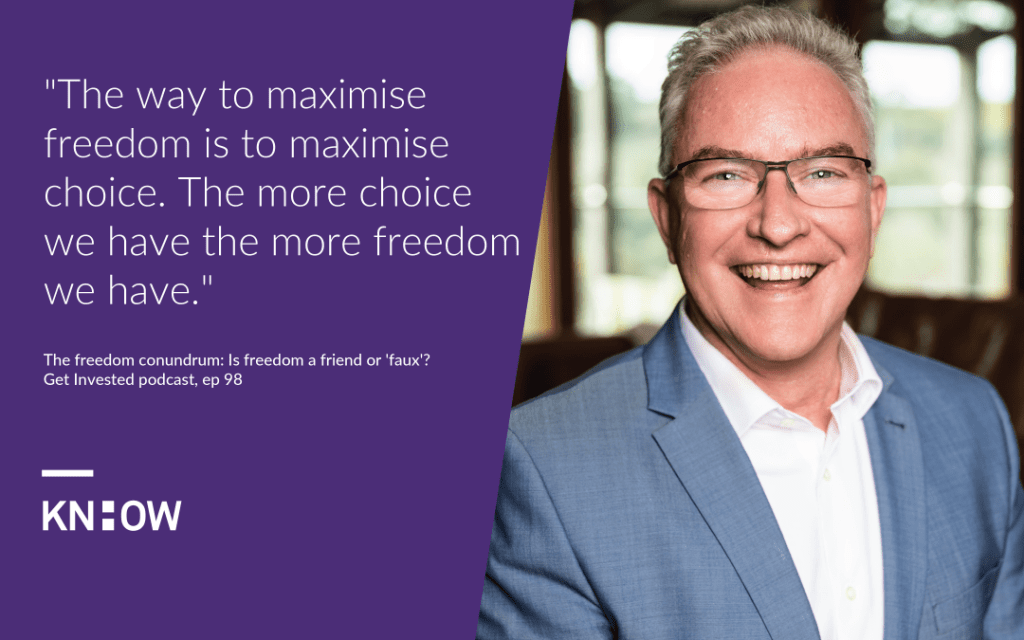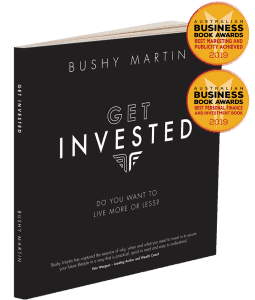For many people who start their own businesses or pursue investment opportunities, freedom is a primary motivator.
Whether it be the freedom to live a certain quality of life, to travel wherever, whenever, or simply the freedom to answer to nobody but oneself, many people consider having choices to be an ultimate measure of success.
There has never been a time in human history when freedom is so obtainable, but it’s also true that, according to numerous studies, people have never been more anxious and more depressed than they are today. According to Beyond Blue and the ABS, one in seven Australians have experienced depression and more than a quarter have experienced an anxiety disorder.
Bushy Martin explored this paradox on the Get Invested podcast, drawing on observations from the book ‘The Paradox of Choice – Why More is Less’, by author Barry Schwartz.
Bushy points out that the world we live in has moved from one of limited choice to unlimited choice in so many aspects of life, but that all that choice can have a number of negative impacts on people.
“One is that it produces paralysis, rather than liberation,” Bushy said.
“With so many options to choose from people find it very difficult to choose at all. Take the example of the famous university ‘Jam Study’. Researchers presented an array of tasty jams and enticed shoppers to buy a jar. In one version, there were six varieties shown to shoppers. In another, there were 24 jams. The second, larger array of jams attracted more interest. But the smaller array led to ten times more jam purchases. Less choice, it appears, leads to more active decisions.”
Bushy has seen this paradox play out in the real world helping investors build good rental homes. One of the building companies he dealt with used to let clients choose from a vast array of options for every aspect of the fit-out of the homes, which meant their design consultants had to spend about 20 hours with each client.
In an attempt to cut costs, the builder dramatically reduced the numbers of options, and Bushy says the results were striking.
“(The) reduced client decision paralysis resulted in four hours with a home consultant rather than 20, there were more purchases, less regret and higher customer satisfaction. The streamlining also enabled the builder to build homes more efficiently and economically because the construction crews could work faster with fewer errors when there were fewer variants,” Bushy said.
“So while choice reduction was undertaken to save money it also increased client purchases and most importantly increased client satisfaction.”
Bushy says this type of paralysis might not matter when choosing a type of bread or coffee, but it does when choosing something extraordinarily consequential, like a life path or life partner. The other effect of too much choice, he says, is that people often end up less satisfied with the choice they made.
“If you buy (something) and it’s not perfect, it then becomes easy to imagine you could have made a different choice that would have been better,” Bushy says.
“The more options there are, the easier it is to regret anything at all that is disappointing about the option you chose.”
Bushy offers a solution to overcoming this paradox – one discussed in Barry Schwartz’s book – that people need to switch from being maximizers to satisficers.
“A maximizer is someone who seeks, expects and accepts only the very best. As a result their choices are more demanding and less fulfilling.
“Imagine that you’re shopping for a pair of runners. If you aspire to make the absolutely best purchase that can be made, and therefore feel the urge to check out the alternatives to be sure that you’ve found just the right pair, you might be a maximizer.
“As a decision strategy, maximizing is an overwhelming task since maximizers aspire to choose only the very best. If you’re a maximizer, every option has the potential to snare you into an endless tangle of considerations.
“Not only do maximizers overwhelm themselves in this way, but once they’ve finally overcome the difficulty of choosing, and actually made their choice, they’re more likely than others to feel unsatisfied with it.”
According to Bushy, there’s a simple choice that can be made to overcome this cycle of disatifaction – becoming a satisficer.
“Schwartz defines a satisficer as someone who’s able to settle for “good enough. With this approach, choices are less demanding and more fulfilling.
“You all know people who can choose quickly and decisively. These people are satisficers and they’re characterised by having a certain standard they adhere to when choosing, instead of having ‘the best’ as their goal.
“Satisficing is a fairly simple decision strategy – it means searching until you find the option that meets your standards, and stopping at that point.
“For instance, a satisficer looking to buy a new pair of training shoes will settle for the first pair she finds that meets her criteria of fit, quality, appearance and price. A satisficer isn’t concerned about better shoes or better bargains just around the corner.”
“Satisficers are more happy with the choices they make, and – importantly – they’re also more happy with life in general. Because, satisficers don’t compare among endless alternatives when choosing and they don’t experience the decrease in satisfaction that comes from contemplating what the other options might have afforded them.
“And since they don’t strive for perfection when making decisions, they won’t spend time thinking about the hypothetical perfect world in which options exist that offer complete satisfaction.”
If you aren’t sure if you are a maximiser or satisficer, listen to the full episode of Get Invested and take the questionnaire described by Bushy to find out which category you fall into.
Listen to the full podcast interview here.
Want to know how you can build wealth with the help of leading, qualified experts? Talk to the team at Know How, now.




